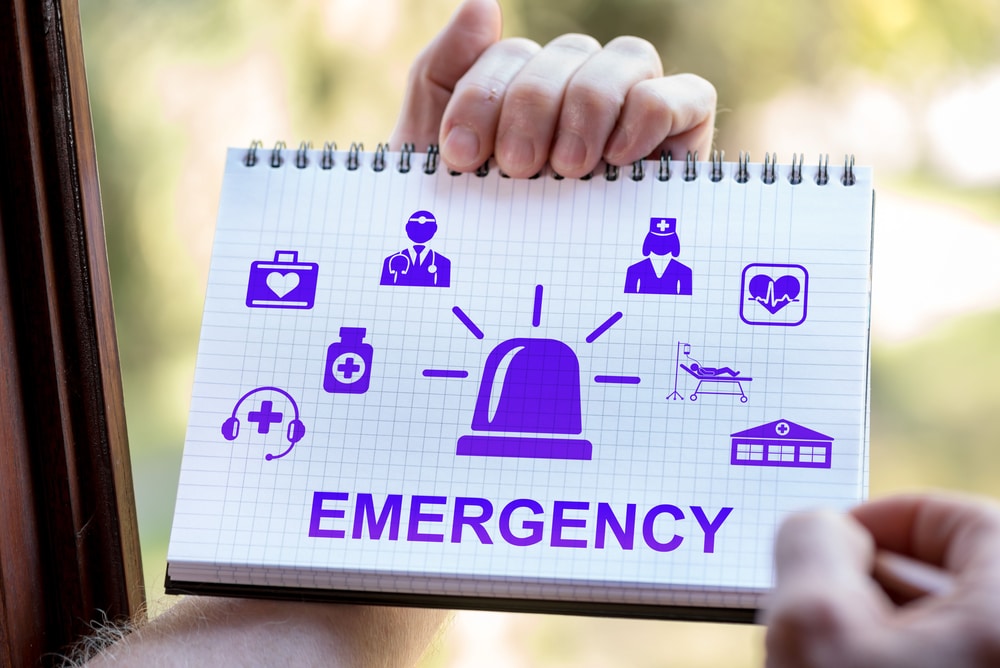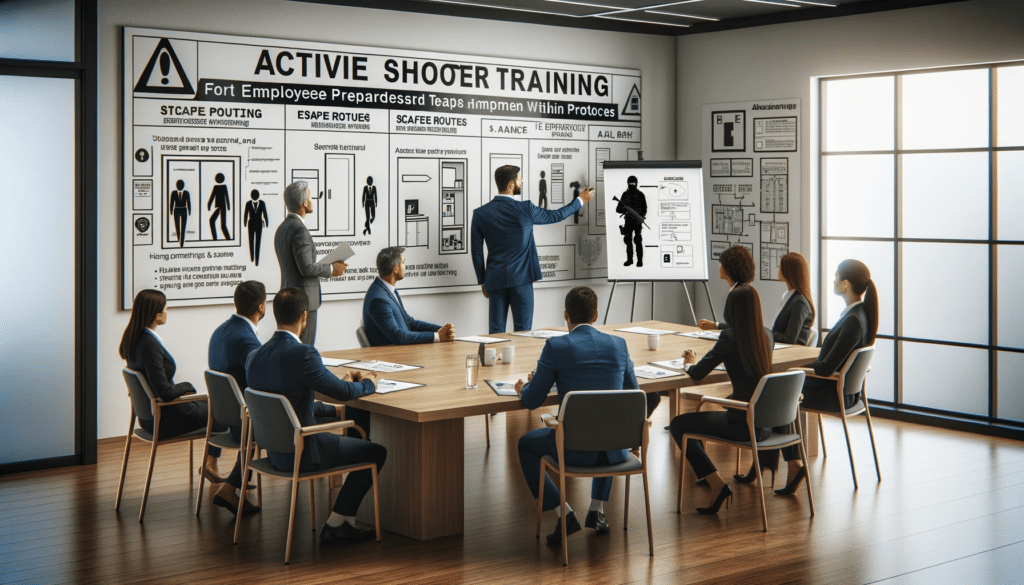How to Run Active Shooter Drills at Work

The importance of preparing for the unexpected cannot be overstated. The rise of active shooter incidents across the United States has prompted businesses to redefine their approach to workplace safety.
One such critical aspect is the implementation of active shooter drills. While it may seem unsettling to contemplate, fostering preparedness is the cornerstone of ensuring the well-being of your team.
In this article, we’ll equip you with the knowledge and strategies needed to conduct active shooter drills at your workplace. This isn’t merely about checking a compliance box; it’s about empowering your staff with the tools to respond decisively in the face of adversity.
Active shooter drills should be part of any active shooter training for your business.
What is an Active Shooter Drill?
In the realm of workplace safety, active shooter drills stand as a crucial component of emergency preparedness. These drills simulate scenarios where an armed individual is actively engaged in harming others within the workplace.
The objective is not to generate fear but to cultivate a sense of readiness, prepare individuals, and save lives, allowing co-workers to respond swiftly and effectively in the face of such a threat.

Are Active Shooter Situation Drills Necessary?
The unfortunate truth is that we live in a world where unforeseen events including gun violence can unfold rapidly. While it’s a distressing thought, the proactive implementation of active shooter drills is a responsible and necessary step in prioritizing the safety of your team.
Consider this: just as we conduct fire drills to ensure a prompt and orderly evacuation, active shooter drills empower your workforce with the skills needed to navigate and survive a dangerous situation.
Benefits of Running Drills for Active Shooter Events
While the idea of active shooter drills may evoke a sense of unease, the benefits they bring to the table are immeasurable. Consider these three compelling reasons why investing time and resources in running drills for active shooter situations is a prudent decision for any organization or workplace:
Heightened Situational Awareness
Active shooter training provides employees with a real-world understanding of potential threats, fostering a heightened sense of situational awareness.
By practicing responses to different scenarios and putting employees in real-time scenarios, individuals can develop the ability to assess situations quickly and make informed decisions, significantly improving their chances of survival.

Enhanced Emergency Response Coordination
Effective communication and coordination are paramount during crises, especially when active shooters are involved. As such, active shooter response and preparedness training is excellent for testing and refining emergency response plans.
With individuals actively engaged, teams learn to work seamlessly together, ensuring a coordinated and swift response in the event of an actual danger. Improved collaboration can significantly impact the outcome in critical moments where time is of the essence.
Reduced Panic & Increased Confidence
Familiarity breeds confidence.
By preparing for an active shooter incident, employees become more comfortable with the procedures and protocols in place, reducing panic in high-stress situations.
Confidence in their ability to respond appropriately to an active shooter event translates to a calmer, more collected workforce, improving overall resilience in the face of adversity.
How to Run Active Shooter Drills: A 3-Step Plan
A meticulously crafted plan, paired with thorough training, can mark the difference between disorder and a well-coordinated response. Thus, let’s explore a 3-step plan to effectively run active shooter drills, ensuring your organization is prepared for the unforeseen.
1. Develop a Plan for Active Shooter Incidents
The first step in running successful active shooter drills is to establish a robust plan for handling such incidents. This plan should be comprehensive, detailing the responsibilities of employees, procedures for reporting potential threats, and clear communication channels in case of an active shooter situation.
- Threat Assessment Program: Employ threat assessment programs to identify and mitigate potential risks within your workplace, and regularly assess warning signs, keeping in mind that the FBI defines specific indicators that may signal a potential danger. By addressing these indicators proactively, you can be on your way towards creating a safer workplace environment.
- Mass Notification System: Implement mass notification systems to alert employees in the event of an active shooter scenario. These systems should provide clear instructions and direct individuals to follow established lockdown procedures; as discussed previously, effective communication is critical in evolving situations, enabling individuals to react and seek safety.
- Shelter Locations: Designate secure shelters within your facility. These areas should be strategically chosen, considering factors such as accessibility, proximity, and the ability to conceal individuals from the view of a potential aggressor. Moreover, be sure to educate employees on these hiding places during active shooter training sessions.

2. Decide Which Kind of Drill to Run
The second step involves deciding the type of active shooter drill best suited for your workplace. Each type serves a distinct purpose in preparing individuals for different aspects of an active shooter incident.
- Lockdown Drills: Focus on a strong lockdown procedure, emphasizing the importance of securing doors and windows, turning off lights, and remaining silent. Train employees on how to create barricades using heavy furniture as a last resort, providing an extra layer of protection against an active shooter attempting to enter their workspace.
- Tactical Shooter Drills: This type of training is conducted with the aid of an external service such as the police. A fake “shooter” is deployed to help employees understand how to react using their taught-and-tested “run, hide, fight” response procedures. Whether it’s a scheduled or unannounced drill, both prove effective. However, it’s essential to acknowledge that the latter can impose undue stress on employees.
- Situational Awareness Training: Incorporate situational awareness training to enhance employees’ ability to assess their surroundings and react appropriately. This training should cover the identification of potential violence, understanding the layout of the environment, and recognizing safe zones within a confined and populated area.
3. Report Results & Reflect with Employees
This last step is frequently disregarded but bears substantial importance in refining your active shooter preparedness plan.
- After-Action Reporting: After each drill, initiate after-action reporting to evaluate the effectiveness of the response. Collect feedback from colleagues, pinpoint areas for enhancement, and adjust the plan accordingly.
- Employee Debriefing: Following the drill, conduct debriefing sessions with employees. Create a space for open dialogue, allowing individuals to share their experiences and express any concerns. Addressing these concerns fosters a supportive environment and builds confidence in the preparedness efforts.
- Continuous Training: Recognize that preparedness and training is an ongoing process. Organize frequent active shooter training sessions to keep employees well-informed and bolster their capability to respond calmly and decisively in the face of actual workplace violence.
Common Questions About Active Shooter Incidents
What should I never do in an active shooter incident?
Maintaining composure is paramount in an active shooter situation.
Never underestimate the importance of remaining calm. Resist the urge to pull out your cell phone and document the incident, as your primary focus should be on finding a secure hiding place. Additionally, refrain from engaging the shooter unless it is an absolute last resort – your priority is self-preservation.
What should I do when law enforcement arrives in an active shooter incident?
Law enforcement and first responders play a pivotal role in neutralizing an individual actively engaged in killing. When law enforcement arrives, follow their instructions promptly.
Keep your hands visible, refrain from any sudden movements, and recognize that law enforcement officers are adeptly trained to manage the situation. Ensuring your cooperation is crucial to secure a safe resolution, potentially saving lives.

Why are schools prone to active shooter incidents?
Schools may be more susceptible to active shooter incidents due to their open nature, high population density, and inadequate school safety practices. Tragically, schools have been the site of numerous mass killings in the US in recent years.
Furthermore, schools are settings where students may undergo intensified emotions, thereby heightening the potential for someone attempting to kill people.
What role does workplace violence play in an active shooter incident?
Workplace violence can be a precursor to active shooter incidents. Disputes between employees, bullying, or harassment can escalate, leading to violent acts.
Employers should address these issues promptly, implementing comprehensive workplace violence prevention programs and fostering a culture of respect to mitigate the risk of such incidents.
How can employers worry less about the risk of active shooters?
Employers can alleviate concerns by prioritizing active shooter preparedness. This can be done by implementing comprehensive training programs, conducting regular drills, and creating a culture of awareness can empower employees to respond effectively.
Are there warning signs that an individual is actively engaged in planning a violent act?
Yes, recognizing signs is crucial for preventing potential violence. These signs may include drastic behavioral changes, expressions of physical aggression, or increased isolation.
Employers should inform employees on promptly recognizing and reporting these signs, enabling early intervention and diminishing the risk of someone attempting to kill people.
How can individual employees contribute to ensuring active shooter preparedness?
Individuals can prepare by actively participating in workplace training programs.
Familiarize yourself with emergency procedures, know the locations of hiding places, and understand how to react during an active shooter situation. Regularly update your knowledge through drills, report any concerns promptly, and just keep contributing to creating a culture of preparedness.
Final Thoughts
Fostering a culture of preparedness through training for an active shooter situation is an unequivocal investment in workplace safety.
Thus, empower your workplace to respond effectively in times of crisis and preserve lives by crafting comprehensive response plans, choosing suitable active shooter drill types, and fostering open communication with your employees.